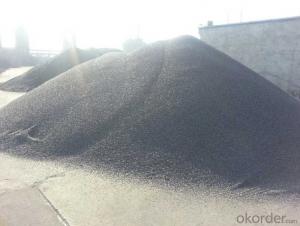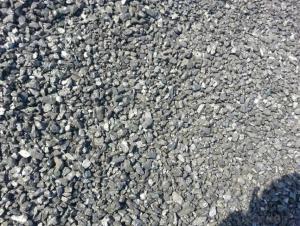Charge Coke FC90-95 with stable quality
- Loading Port:
- Tianjin
- Payment Terms:
- TT OR LC
- Min Order Qty:
- 20 m.t.
- Supply Capability:
- 3000 m.t./month
OKorder Service Pledge
OKorder Financial Service
You Might Also Like
Packaging & Delivery
25kgs/50kgs/1ton per bag or as buyer's request
Specifications
Calcined Anthracite
Fixed carbon: 90%-95%
S: 0.5% max
Size: 0-3. 3-5.3-15 or as request
It used the high quality anthracite as raw materials through high temperature calcined at over 2000 by the DC electric calciner with results in eliminating the moisture and volatile matter from anthracite efficiently, improving the density and the electric conductivity and strengthening the mechanical strength and anti-oxidation. It has good characteristics with low ash, low resistvity, low sulphur, high carbon and high density. It is the best material for high quality carbon products.
Advantage and competitive of caclined anthracite:
1. strong supply capability
2. fast transportation
3. lower and reasonable price for your reference
4.low sulphur, low ash
5.fixed carbon:95% -90%
6..sulphur:lower than 0.3%
General Specification of Calcined Anthracite:
| FC | 95 | 94 | 93 | 92 | 90 |
| ASH | 4 | 5 | 6 | 6.5 | 8.5 |
| V.M. | 1 | 1 | 1 | 1.5 | 1.5 |
| S | 0.3 | 0.3 | 0.3 | 0.35 | 0.35 |
| MOISTURE | 0.5 | 0.5 | 0.5 | 0.5 | 0.5 |
Pictures

We are also strong at below materials, please contact us if you are interested in any of them:
Calcined Petroleum Coke
Carbon Electrode Paste
Carbon Electrode
- Q:What are the impacts of carbon emissions on the stability of mountains?
- Carbon emissions can have various impacts on the stability of mountains. One significant effect is the acceleration of glacial melting, leading to increased water runoff and the potential for more frequent and severe landslides. Additionally, carbon dioxide contributes to the acidification of rainwater, which can corrode rocks and weaken the stability of mountain slopes. Climate change, driven by carbon emissions, also leads to alterations in precipitation patterns, temperature, and weather events, increasing the risk of erosion, rockfalls, and avalanches. Overall, carbon emissions have a detrimental influence on the stability of mountains, posing risks to both human populations and ecosystems.
- Q:How does carbon dioxide affect textile production?
- Carbon dioxide affects textile production in several ways. Firstly, the production of synthetic fibers such as polyester and nylon, which are widely used in the textile industry, involves the emission of carbon dioxide during the manufacturing process. This contributes to greenhouse gas emissions and climate change. Additionally, carbon dioxide is released during the combustion of fossil fuels used for energy in textile factories. This not only adds to the environmental impact but also affects air quality and human health. Moreover, the dyeing and finishing processes in textile production often require the use of chemicals that emit carbon dioxide when they break down or react with other substances. These emissions further contribute to the carbon footprint of the industry. Overall, carbon dioxide has a significant impact on textile production, primarily through the emissions generated during fiber manufacturing, energy consumption, and chemical usage. Therefore, efforts to reduce carbon dioxide emissions and transition to more sustainable practices are crucial for mitigating the environmental impact of the textile industry.
- Q:What is carbon dating and how does it work?
- Carbon dating is a scientific method used to determine the age of organic materials, such as plant or animal remains, by measuring the amount of radioactive carbon-14 present in the sample. Carbon-14 is a naturally occurring isotope of carbon that is constantly formed in the atmosphere through the interaction of cosmic rays with nitrogen atoms. Living organisms absorb carbon-14 while they are alive, and the level of carbon-14 in their tissues remains relatively constant. However, once an organism dies, it no longer takes in carbon-14, and the amount of carbon-14 in its remains gradually decreases over time through radioactive decay. By comparing the ratio of carbon-14 to stable carbon-12 in a sample, scientists can estimate the age of the organic material using known decay rates.
- Q:What is carbon nanocomposite?
- Carbon nanocomposite refers to a type of material that combines carbon nanotubes or graphene with a matrix material, such as polymers or metals, to form a composite material. The carbon nanotubes or graphene are typically added in small amounts, often in the form of nanoparticles, to enhance the mechanical, electrical, and thermal properties of the composite material. Carbon nanotubes are cylindrical structures made up of carbon atoms arranged in a hexagonal lattice, while graphene is a single layer of carbon atoms arranged in a two-dimensional lattice. These carbon-based materials possess exceptional properties, such as high strength, electrical conductivity, and thermal conductivity. When incorporated into a composite material, these properties can be transferred to the overall structure, resulting in improved performance. The use of carbon nanocomposites has been explored in various industries and applications. In aerospace, for example, these materials have been investigated for their lightweight and high-strength properties, which could potentially enhance the fuel efficiency and durability of aircraft components. In electronics, carbon nanocomposites have shown promise for developing high-performance sensors, conductive films, and energy storage devices. Additionally, they have been studied for their potential applications in medical devices, automotive parts, and energy storage systems. Overall, carbon nanocomposites offer the opportunity to create materials with enhanced properties by leveraging the unique characteristics of carbon nanotubes or graphene. However, the production and scalability of these materials still pose challenges, and further research is needed to optimize their performance and cost-effectiveness for various applications.
- Q:How is carbon used in the production of pigments?
- The ability of carbon to create vibrant and deep colors makes it a common choice for pigments. These pigments, also known as carbon blacks, are produced by incomplete combustion of hydrocarbons like natural gas or petroleum. The resulting carbon particles are then processed and purified to create a fine powder that serves as a pigment. Various industries, including inks, paints, plastics, and cosmetics, utilize these carbon-based pigments. In the ink production process, carbon black is frequently added to enhance color intensity and opacity. Similarly, in the manufacturing of paints and coatings, it is used to provide a rich and deep black color. Plastics can be enhanced by adding carbon black, which improves their UV resistance, making them more durable and long-lasting. This is especially crucial for outdoor applications where exposure to sunlight can lead to fading and degradation. Carbon-based pigments are also widely used in the cosmetics industry. They are incorporated into products like eyeliners, mascaras, and lipsticks to create intense black or dark shades. The stability and consistent color delivery of carbon black pigments make them a preferred choice in cosmetics. In summary, the ability of carbon to create vibrant and deep colors makes it extensively used in pigment production. Carbon-based pigments have diverse applications in various industries, enhancing color intensity, providing UV resistance, and delivering rich black shades.
- Q:Is there a line cutting of carbon fibers?
- The principle of ultrasonic cutting machine is completely different from traditional cutting. It is the use of ultrasonic energy, will be cut materials local high-speed vibration, so as to achieve the purpose of cutting materials.Water cutting is the formation of water through high pressure jet, for carbon fiber board also need to add hard abrasive in water, called water jet cuttingFor complete curing of the carbon fiber composite plate, if there is no special requirements, with diamond grinding tools can also cut the general. I don't know what you're asking for.Carbon fiber composite cutting methods are many, and laser cutting, etc., need to be selected according to specific circumstances and requirements.
- Q:Speak in detail! I am ~ carbon Roast Lamb Leg lamb chops lamb barbecue ah ~ ~ how to do with practice video line! And how do you bake the oven?
- Step 1: the leg with a knife cut, and then put into the seasoning pickled, according to the guests taste add salt, pepper, fennel, pepper and so on, this time can not add cumin. These ingredients should be fully blended and then applied to the surface of the meat. Then sealed with a sealed instrument to allow the meat to be fully salted and flavored, preferably 3 hours.
- Q:Often see the so-called 30T, 46T, 60T carbon fiber, 60T carbon fiber, equivalent to T hundreds of carbon fibers, is T800, or T1000? I'm not very good at parameter conversion. Is there a parameter list? How do I correspond to the T300T700T800 performance parameter table?
- Two, 46T, 60T refers to high modulus carbon fibers. M series; T1000 refers to the high strength carbon fiber, belonging to the T series; M series and T series belong to different performance products.
- Q:What are the advantages and disadvantages of carbon monoxide and carbon dioxide?
- Using carbon dioxide instead of traditional organic solvents to spray paint can effectively reduce the amount of harmful substances released into the atmosphere during the process of spraying. In the high-tech, carbon dioxide has its use for laser treatment using carbon dioxide instead of helium neon, can reduce the pain of patients, and save the cost for carbon dioxide extraction of egg yolk lecithin, considerable economic benefit. Carbon dioxide can be used to wash clothes, and does not pollute the environment, but also a wide range of sources. These are all benefits. The downside is the increased carbon dioxide caused by the greenhouse effect, resulting in the polar melting glaciers, rising sea levels, threatening the coastal city, the land salinization of coastal areas, increasing the difficulty of development, increasing temperature also makes the melting of snow in some of the top of the hill, the snow melt water resources of river water to reduce or even stop the phenomenon to occur, the affected area production activities. The increase of the atmospheric temperature, resulting in carbon dioxide absorption in some marine algae wantonly breeding, resulting in the death of algae absorb carbon dioxide, indirectly affect the fishery breeding, and the carbon dioxide in the atmosphere increases toward the vicious spiral. Take | enthusiastic users on 2013-11-09 12:52
- Q:Whether the CO2 content in the boiler smoke can not be measured, the measurement of carbon content of fly ash ah? @ @ Thank you very much!!!
- Just like oxygen measuring zirconia, the CO2 content has a specialized CO2 sensor that can be measured directly
1. Manufacturer Overview |
|
|---|---|
| Location | |
| Year Established | |
| Annual Output Value | |
| Main Markets | |
| Company Certifications | |
2. Manufacturer Certificates |
|
|---|---|
| a) Certification Name | |
| Range | |
| Reference | |
| Validity Period | |
3. Manufacturer Capability |
|
|---|---|
| a)Trade Capacity | |
| Nearest Port | |
| Export Percentage | |
| No.of Employees in Trade Department | |
| Language Spoken: | |
| b)Factory Information | |
| Factory Size: | |
| No. of Production Lines | |
| Contract Manufacturing | |
| Product Price Range | |
Send your message to us
Charge Coke FC90-95 with stable quality
- Loading Port:
- Tianjin
- Payment Terms:
- TT OR LC
- Min Order Qty:
- 20 m.t.
- Supply Capability:
- 3000 m.t./month
OKorder Service Pledge
OKorder Financial Service
Similar products
New products
Hot products
Related keywords




























